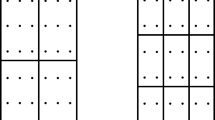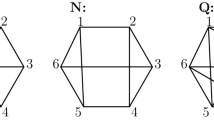Abstract
The maximum number of mutually orthogonal latin squares (MOLS) of order 10 is known to be between 2 and 6. A hypothetical set of four MOLS must contain at least one of the types of group divisible designs (GDDs) classified here. The proof is based on a dimension argument modified from work by Dougherty. The argument has recently led to the discovery of a counterexample to Moorhouse’s conjecture on the rank of nets, found by Howard and Myrvold. Although it is known that even three MOLS can admit no nontrivial symmetry group, we are hopeful this classification via GDDs and dimension can offer some structure to aid the eventual goal of exhausting the search for four MOLS of order 10.
Similar content being viewed by others
References
Bose R.C., Shrikhande S.S.: On the falsity of Euler’s conjecture about the non-existence of two orthogonal Latin squares of order 4t + 2. Proc. Natl Acad Sci. U.S.A. 45(5), 734–737 (1959)
Bose R.C., Shrikhande S.S., Parker E.T.: Further results on the construction of mutually orthogonal Latin squares and the falsity of Euler’s conjecture. Can. J. Math. 12, 189–203 (1960)
Bruck R.H.: Finite Nets II. Uniqueness and embedding. Pac. J. Math. 13, 421–457 (1963)
Colbourn, C.J., Dinitz, J.H. (eds): The CRC Handbook of Combinatorial Designs, 2nd edn. CRC Press, Boca Raton (2006)
Delisle E.: The search for a triple of mutually orthogonal latin squares of order ten: looking through pairs of dimension thirty-five and less. M.Sc. Thesis, University of Victoria (2010).
Dougherty S.T.: A coding theoretic solution to the 36 officer problem. Des. Codes Cryptogr. 4, 123–128 (1994)
Hall M. Jr.: Combinatorial Theory, 2nd edn. Wiley, New York (1986)
Howard L., Myrvold W.: A counterexample to Moorhouse’s conjecture on the rank of nets. Bull. Inst. Combin. Appl. 60, 101–105 (2010)
Lam C., Thiel L., Swiercz S.: The non-existence of finite projective planes of order 10. Can. J. Math. XLI(6), 1117–1123 (1989)
McKay B.D., Meynert A., Myrvold W.: Small Latin squares, quasigroups, and loops. J. Combin. Des. 15(2), 98–119 (2006)
Moorhouse G.E.: Bruck nets, codes and characters of loops. Des. Codes Cryptogr. 1, 7–29 (1991)
Parker E.T.: Constructions of some sets of pairwise orthogonal Latin squares. Proc. Natl Acad Sci. U.S.A. 45, 859–862 (1959)
Stinson D.R.: A short proof of the nonexistence of a pair of orthogonal Latin squares of order six. J. Combin. Theory Ser. A 36, 373–376 (1984)
Author information
Authors and Affiliations
Corresponding author
Additional information
Communicated by C. Mitchell.
Rights and permissions
About this article
Cite this article
Dukes, P., Howard, L. Group divisible designs in MOLS of order ten. Des. Codes Cryptogr. 71, 283–291 (2014). https://doi.org/10.1007/s10623-012-9729-8
Received:
Revised:
Accepted:
Published:
Issue Date:
DOI: https://doi.org/10.1007/s10623-012-9729-8




